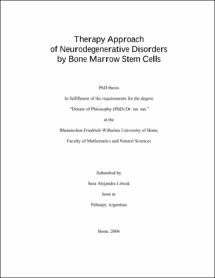Therapy Approach of Neurodegenerative Disorders by Bone Marrow Stem Cells

Therapy Approach of Neurodegenerative Disorders by Bone Marrow Stem Cells

| dc.contributor.advisor | Neumann, Harald | |
| dc.contributor.author | Litwak, Sara Alejandra | |
| dc.date.accessioned | 2020-04-10T19:13:56Z | |
| dc.date.available | 2020-04-10T19:13:56Z | |
| dc.date.issued | 2007 | |
| dc.identifier.uri | https://hdl.handle.net/20.500.11811/3168 | |
| dc.description.abstract | Multiple Sclerosis and cerebral ischemia are severe neurodegenerative diseases. Treatment in both cases is inadequate as drug delivery to the central nervous system (CNS) represents a difficulty due to the presence of the blood-brain-barrier (BBB) and its control of molecule trafficking. The migration and integration into CNS parenchyma of adult stem cell coming from bone marrow (BM) has been widely reported suggesting their potential as cell therapy themselves, but also as means for local delivery of therapeutic agents. In this work, the isolation of a cell population derived from the mouse bone marrow (BM), which is enriched in hematopoietic progenitor/stem cells (termed Lin-HSC) and their application in two neurodegenerative paradigms: the animal model for multiple sclerosis, Experimental Autoimmune Encephalomielitis (EAE), and the animal model for cerebral ischemia were described. Furthermore, the use of these cells as delivery system for a potential therapeutic factor, Neurotrophin-3 was studied. Lin-HSC were isolated and characterized by flow cytometry and quantitative real time PCR. Lin-HSC showed no expression of blood lineage differentiated cells neither of the receptors and integrins, but were positive for c-kit (29%) and CD45 (58%). Relative gene transcript levels of BDNF, bFGF, GDNF, NGF, NT3, TGF-ß, VEGF were not relevant in the Lin-HSC population when comparing to total BM. While the inflammatory cytokines TNF-α, IFN-γ and IL-1ß where reduced in comparison with BM that contains already matured blood cells. The EAE model was induced by active immunization with myelin oligondendrocyte glycoprotein. GFP positive Lin-HSC were intravenously injected at the peak of the disease. Five days after application cells migrated and remained specifically into the lesion sites in the spinal cord. In average 25.4±14.5 cell/mm2 were found and they down-regulated their CD45 expression while being positive for IsolectinB4 marker. Therefore a microglial/macrophage phenotype of the migrated cells is suggested. Lin-HSC were not able to interfere with the EAE symptoms when injected alone, or genetically modified to over-express a neuroprotective factor, Neurotrophin-3. Advanced state of inflammation and poor local release of the factor could explain the unsuccessful approach. The animal model of cerebral ischemia was established by middle cerebral aorta occlusion. Lin-HSC stem cells were injected 24 hours after ischemia induction. Lin-HSC stem cells migrated into the peri-infarct zone after intravenous application. Cells found in the brain displayed an IsolectinB4 and CD11b positive phenotype. Brain hemispheres of Lin-HSC injected mice showed a reduced infract size and decreased recruitment of inflammatory cells to lesion site when comparing with PBS injected controls. Analysis by real time PCR showed that Lin-HSC were not able to give direct trophic support within ischemic regions but rather influenced by reducing peripheral immune activation. | en |
| dc.language.iso | eng | |
| dc.rights | In Copyright | |
| dc.rights.uri | http://rightsstatements.org/vocab/InC/1.0/ | |
| dc.subject | Multiple Sclerosis | |
| dc.subject | Cerebral ischemia | |
| dc.subject | Bone Marrow Hematopoietic Stem Cells | |
| dc.subject | Cell therapy | |
| dc.subject | Lentiviral system | |
| dc.subject.ddc | 570 Biowissenschaften, Biologie | |
| dc.title | Therapy Approach of Neurodegenerative Disorders by Bone Marrow Stem Cells | |
| dc.type | Dissertation oder Habilitation | |
| dc.publisher.name | Universitäts- und Landesbibliothek Bonn | |
| dc.publisher.location | Bonn | |
| dc.rights.accessRights | openAccess | |
| dc.identifier.urn | https://nbn-resolving.org/urn:nbn:de:hbz:5N-12352 | |
| ulbbn.pubtype | Erstveröffentlichung | |
| ulbbnediss.affiliation.name | Rheinische Friedrich-Wilhelms-Universität Bonn | |
| ulbbnediss.affiliation.location | Bonn | |
| ulbbnediss.thesis.level | Dissertation | |
| ulbbnediss.dissID | 1235 | |
| ulbbnediss.date.accepted | 05.03.2007 | |
| ulbbnediss.fakultaet | Mathematisch-Naturwissenschaftliche Fakultät | |
| dc.contributor.coReferee | Hoch, Michael |
Files in this item
This item appears in the following Collection(s)
-
E-Dissertationen (4442)




